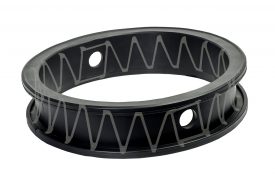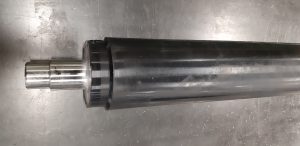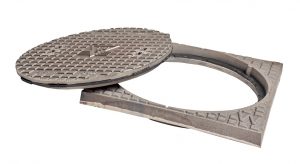How can you connect rubber and metal?

How can you connect rubber and metal? Rubber and metal are not materials that associate naturally by nature; nevertheless, they are often connected to each other, as metal can provide additional strength or support for some rubber products. The metal in a rubber-metal connection can also serve as a fixing element or may complement the product. By combining the two materials, strength and flexibility are achieved in one and the same product, providing solutions for many applications.
Before these materials can be bonded, the metal must be pre-treated. This treatment takes place in our metal pre-processing department, where all the necessary resources are available to prepare the metal for the bonding process. This preparation is crucial to achieving an effective connection between rubber and metal.
Development of rubber-metal connections
Rubber-metal connections are the result of a carefully thought-out process. All handling steps are devised beforehand by RIS themselves. Using dedicated software, we determine exactly where we need to connect the rubber to the metal to achieve optimal functioning of the final product. The degree of degreasing and roughening of the metal, as well as the thickness of the adhesive priming layer are also ascertained beforehand. This comprehensive information is put together by our metal pre-processing department, where the metal is prepared for the bonding process according to the instructions. Rubber and metal can be connected in various ways.

Chemical connection of rubber and metal
A thorough pre-treatment is key to achieving an effective bond between the materials. The first step in chemically connecting rubber to metal is the degreasing of the metal. The next step is the roughening of the metal element, which often takes place in one of our blast cabinets; the dimensions of the largest cabinet are 4 x 6 metres. Blasting is an effective method for the cleaning and roughening of metal. It involves blasting the product with steel grit using compressed air. This grit blasting ensures that any dirt such as rust, oil or paint residue is removed from the metal element, and at the same time, the roughening increases the surface area of the metal component. This lays the foundation for achieving an optimal bonding structure for further processing.
The next step is the application of an adhesive layer to the metal product. The adhesive is applied to the rough metal in the area where the rubber needs to vulcanise firmly, either manually or using a robot sprayer. It is essential that the adhesive layer is neither too thick nor too thin. The adhesive layer enables the connection of the rubber to the metal by heating (vulcanising).
In short; proper pre-processing of the metal and the correct application of an adhesive primer ensure that the metal is ready for the bonding process. An effective rubber-metal connection is the result of the careful execution of all these process steps.
Mechanical connection of rubber and metal
Connecting rubber to metal mechanically is a much easier process. How the rubber will be fixed to the metal must be carefully worked out beforehand. For example, a niche or holes may be made in the metal so that rubber will flow into or through these openings during the vulcanising process. The rubber and metal will then remain firmly connected.

Our technical department first decides on the best way to make the connection. These ideas are translated into a quote, and if the customer is satisfied we start the production of the mould and samples. Following the approval of the samples, serial production can be started.
Having been active in the rubber industry for more than 70 years, RIS Rubber has a wealth of expertise and experience, and this knowhow, combined with the flexibility of rubber as a product, means that a solution can always be found for your problem. Please do not hesitate to contact us without obligation to discuss the possibilities.
Testing of rubber-metal connections
Thanks to our comprehensive in-house testing facilities, rubber-metal products can be tested in various ways whenever necessary. Read more about the testing of rubber products here.
Let’s make things together!
We create the solution together.

